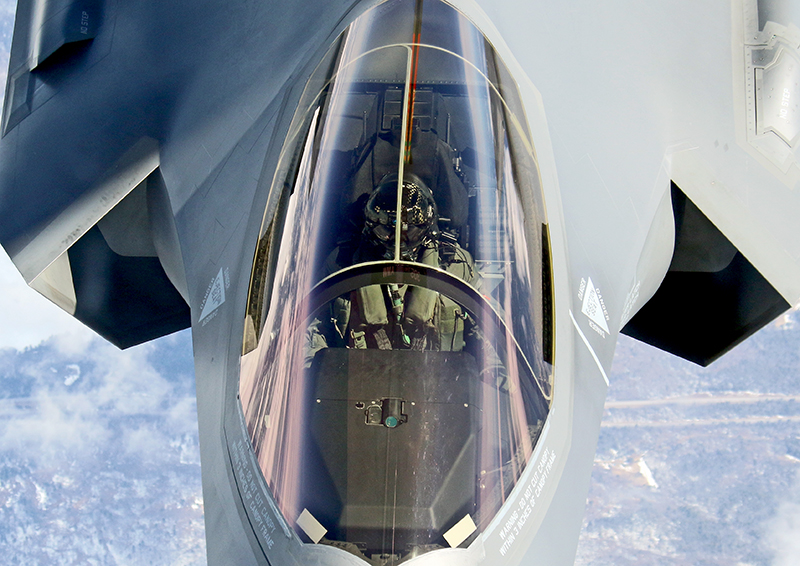We Flew a Refueling Mission with the F-35A Joint Strike Fighter and F-15C Eagle.
Four miles above the open Atlantic I’m sitting in the cockpit of a KC-10 tanker with a hundred tons of explosive jet fuel under me. We’re flying at about 400 MPH. We gingerly inch upward toward another 181-foot long tanker aircraft. That enormous aircraft is only 30-feet away now.
And the air is getting rough.
Lt. Col. Brian Huster of the 78th Air Refueling Squadron of the U.S. Air Force Reserve, sitting left seat, pilot in command, works the plane’s control yoke like an arm wrestler in a cowboy bar. It swings forward and back, left and right through alarmingly large arcs. Despite, or rather because of, his rather physical control inputs our giant tanker remains rock steady. He somehow anticipates every buffet from the turbulent air coming off the vortex of the plane in front of us, anticipating control inputs to keep our KC-10 motionless under the big tanker only feet above our heads in the 400 MPH slipstream four miles above the freezing ocean.
We inch closer to the other aircraft, it’s massive hulk filling our windscreen above our heads. The refueling boom passes several feet over us, just feet from our windscreen. There is a low “clunk” above my right ear. We make contact with the tanker above us and the ride becomes decidedly smoother. Lt. Col. Huster’s job becomes a good bit easier now.
I’ve just joined the small fraternity of people who have refueled in a jet aircraft in midair.
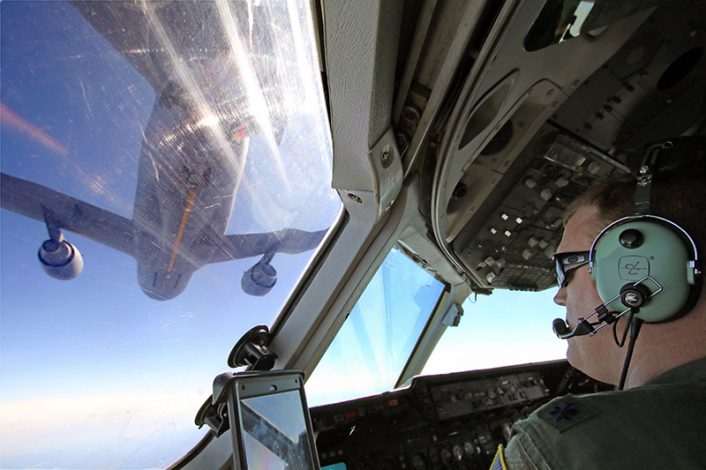
Demerly/TheAviationist.com)
I’m flying with the 514th Air Mobility Wing, U.S. Air Force Reserve, out of Joint Base McGuire-Dix-Lakehurst on America’s east coast. The 514th AMW is one of two units in the U.S. Air Force flying the KC-10 Extender. In addition to performing the air refueling mission the versatile KC-10 can also carry substantial cargo payloads over 4,000 miles making this aircraft an important strategic asset. Not only can the KC-10 support tactical aircraft in the midair refueling role, it can also deploy with their support crews and mission critical gear around the world, providing a unique combined tanker and cargo capability for rapid response around the globe.
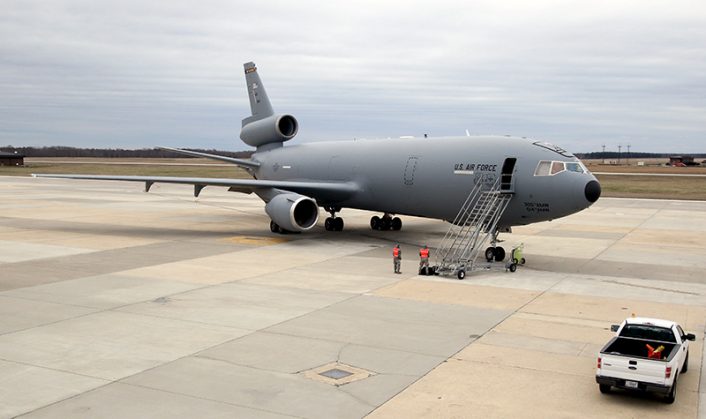
We’re back over the U.S. mainland now. I’ve moved from the cockpit of our giant KC-10 tanker all the way back to the refueling bay in the rear of the aircraft. By comparison to other aerial tankers the KC-10’s refueling bay is spacious and comfortable. Strapped into my own seat just right of the boom operator I have a panoramic view of the earth 22,000 feet below. Broken cumulus at 10,000 feet over the snow-patched green east coast farms of New Jersey slowly cascade beneath us.
In utter silence a ghostly grey F-35A Lightning II slips under us from the right side of the aircraft. It’s eerie how quiet it is. Like a real-world Darth Vader its pilot sits under a tinted canopy wearing his custom carbon fiber helmet that interacts with the F-35A’s many sensors and systems. And exactly like a character from Star Wars his helmet helps the F-35A pilot see and hear everything around him throughout angles and at distances that would be impossible for normal human senses. My first impression looking down on the joint strike fighter pilot 30-feet from us is that he is a real-world cyborg, a living part of an advanced next generation machine that shares information with other aircraft and weapons systems, monitors the entire battlespace with clairvoyant reach and awareness and reacts almost automatically. The pilot under that custom carbon fiber helmet is the brains of it all.
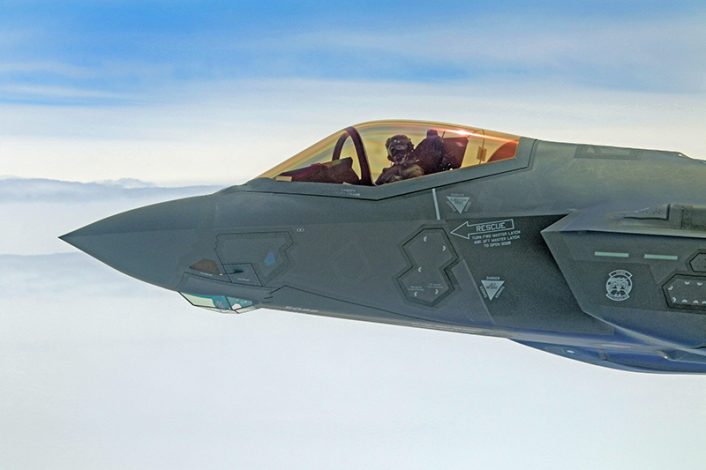
I had read the stories about midair refueling. The drama of the 6,800-mile-long Black Buck mission by the RAF to attack the Falkland Islands after the Argentinean invasion in 1982. The desperate tanker missions over North Vietnam in the ‘60’s and ‘70’s to save pilots from ejecting and being imprisoned in the Hỏa Lò POW camp, the infamous “Hanoi Hilton”. In 2016 CNN’s Zack Cohen reported on a story that apparently still remains partially classified. An F-16 from an unspecified country could not access his onboard fuel during a 2015 combat mission over ISIS held territory. As was the tragic case of both a Jordanian and Russian combat pilot, going down over ISIS held territory is a death sentence for a combat pilot even if he does survive the ejection. The tanker crew flew with the malfunctioning F-16, refueling the aircraft every 15 minutes to keep it in the air until it reached safety. I also read USAF Lt. Col. Mark Hasara’s excellent book, “Tanker Pilot, Lessons from The Cockpit”. In the literature of aviation history, there are too many stories of heroism and daring by tanker crews to recount.
None of the books or history lessons or classes in the military prepared me for the real-life science fiction of what is unfolding in front of me now.
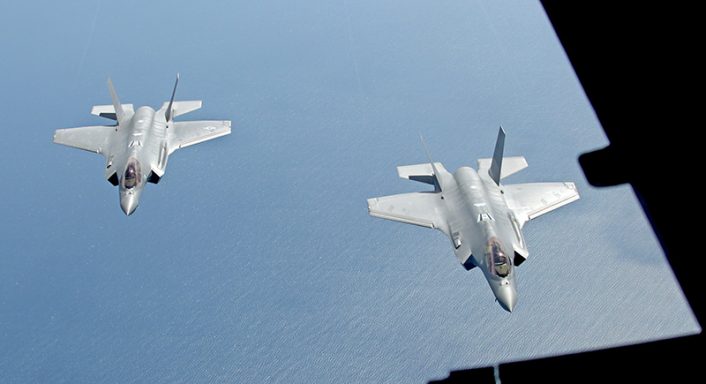
With unusual grace and almost slow-motion gentleness the F-35A tucks under us and smoothly levitates upward toward our refueling boom. As a practical courtesy, our boom operator sitting to my left scoots the refueling boom over the right side of our aircraft, away from the dark-tinted canopy of the F-35A as it inches forward. Two small doors cantilever open on the F-35A’s back. The refueling receptacle on the F-35A is behind the cockpit where the pilot has to observe it with some kind of a sensor, maybe in his helmet, maybe from training, maybe both- it likely remains part of the vast amount of classified information about the F-35A.
Our refueling boom connects with the F-35A in one smooth attempt. A whirring noise over my head tells me fuel is flowing from our tanks into the F-35A now. The pilot below us glances up at us through his canopy, and I get goosebumps. This is the manifestation of the most modern warfighting capability on earth. The combination of the F-35A and the KC-10 grant the U.S. Air Force the ability to strike anytime, in any conditions, with impunity and without detection.
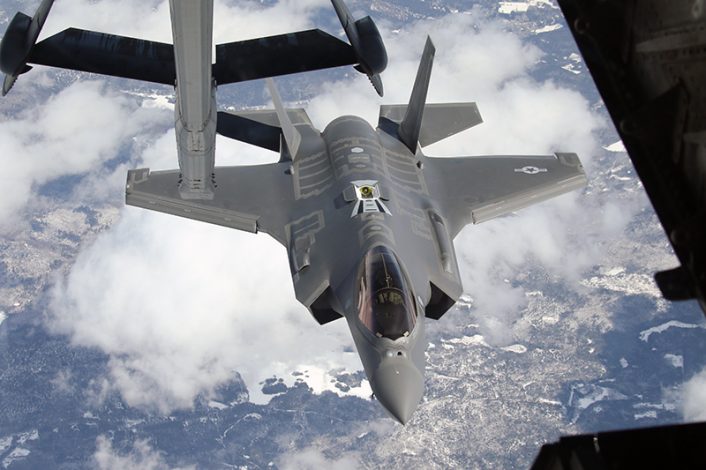
Just a few feet below us the F-35A Lightning II remains rock-steady on the tanker boom. High overcast gives way to broken cloud and a spectacular backdrop of the Atlantic opens up beneath us. The lighting changes for the better, and I am hammering away at the shutter release on my camera.
In the history and literature of midair refueling there are countless stories of how difficult and dangerous it can be, but this crew makes the task look quiet, relaxed and effortless. Of course, this is daytime and the weather is fine. At night, in a thunderstorm, over enemy territory while low on fuel and with battle damage, it is an entirely different affair.
Aerial refueling started on a regular basis after WWII using techniques developed largely by the RAF and later improved upon by the USAF. In 1949, a USAF B-50 Superfortress, an up-engined version of the B-29, completed a non-stop circumnavigation of the earth using aerial refueling. According to historical references, nearly every mission flown during the Gulf wars and the Global War on Terror included aerial refueling.
In January 2017, B-2 Spirit long-range bombers used a total of 15 aerial tankers, both KC-10s and KC-135s, to fly a non-stop 30-hour strike mission against ISIS targets in Libya. The strategic implications of aerial refueling have completely changed the reach of U.S. airpower, effectively putting every place on the globe within range of a relief mission, security flight or strike mission from a U.S. base somewhere in the world. It has also subverted diplomatic constraints on U.S. air operations, granting virtual impunity to the air assets of our nation in the global theater. When France, Spain and Italy prohibited overflight of U.S. F-111 strike aircraft during the 1986 Operation El Dorado Canyon, the U.S. air strike on Libya in retaliation for a terrorist bombing in West Berlin where U.S. servicemen died, the aircraft had to fly an additional 1,300 miles. They simply used aerial refueling to fly around those countries.
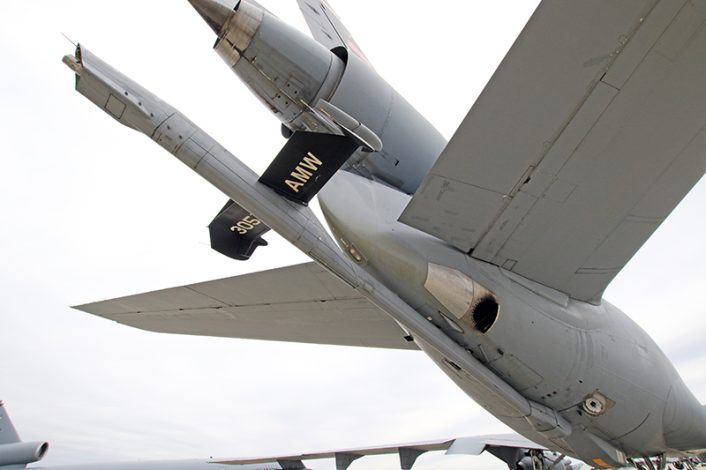
Especially in recent conflicts where air power is critical, the message is clear: Aerial refueling is a powerful strategic and tactical force multiplier.
The two F-35As refuel quickly and smoothly, on and off our boom in eerie near-silence. They scoot to our right wing as a beautiful two-tone F-15C Eagle slides into place below our tanker. The contrast between the fifth-generation F-35A and the F-15C is immediately apparent. The F-15C Eagle is from the 104th Fighter Wing of the Massachusetts Air National Guard. The Eagle joins us from Barnes Air National Guard Base in Westfield, Massachusetts. She takes fuel through her left forward wing root. Sliding into place on the tanker boom is a different procedure than the F-35A. Our Eagle driver plugs into the tanker boom on the first attempt. Fuel begins to whir into his gas tanks from the refueling boom over our heads.
Our tanker spends almost three hours “tanking” F-35s and an F-15C as it enters a wide oval racetrack pattern over the eastern U.S. I can’t help but wonder what this looks like from the ground, or if anyone down there even notices the aerial ballet unfolding four miles above them.

This is the jubilance of flight, the wide-open view of the refueling window, the close company of the exotic fighters. Nothing in aviation matches this experience. One of our boom operators, TSgt. Rob White, a veteran of Iraq, Afghanistan, and “more” he doesn’t want printed, has 2000 hours in the boom seat of a tanker, 500 of them in combat. He has been tanking planes for over 7 years and has put gas on board every aircraft in the U.S. arsenal with aerial refueling capability and many allied aircraft as well. He tells me the most interesting aircraft he refueled was an Australian P-3 Orion maritime patrol plane.
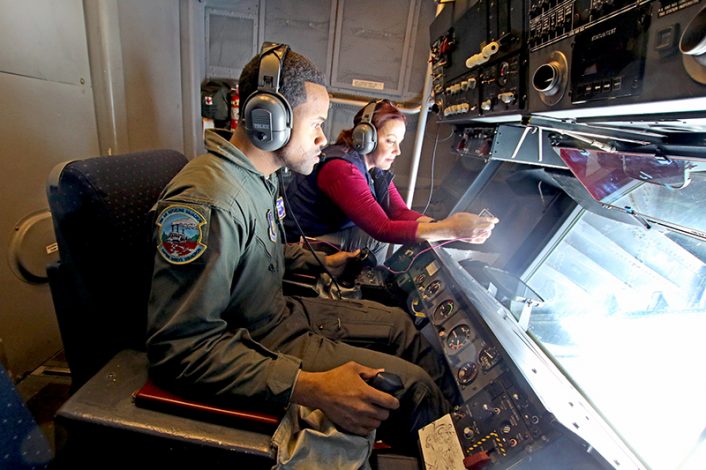
Well before I’d like to we’ve left the tanker track and are descending back toward Joint Base McGuire-Dix-Lakehurst to land. We talk about the future of KC-10 Extender, destined for eventual replacement by the new, modernized Boeing KC-46 Pegasus tanker. But a report by Samantha Masunaga for the Los Angeles Times published on April 11, 2018 says the new KC-46 may not be ready for the Air Force as soon as originally expected.
Masunaga reports, “Delivery of the first KC-46 aircraft — last planned for August 2017 — is now expected to be more than a year late, and technical issues have cropped up during development and testing.”
The new KC-46 will use several advanced systems that include a boom operators’ station served by a video feed from the rear of the aircraft instead of the wide window only feet from the aircraft taking on fuel in the KC-10. There are advantages to the new system, and the KC-46 represents a leap forward for the USAF tanker fleet, especially over the aging KC-135 tankers that are even older than the KC-10. But I will miss the view out of the back of the KC-10. If you love aircraft and our Air Force as much as I do, that seat at the back of a KC-10 is the best view in the world.
The Aviationist wishes to thank the 514th Air Mobility Wing Public Affairs Office and Lt. Col. Kimberly Lalley for their generous assistance in the preparation of this report.

